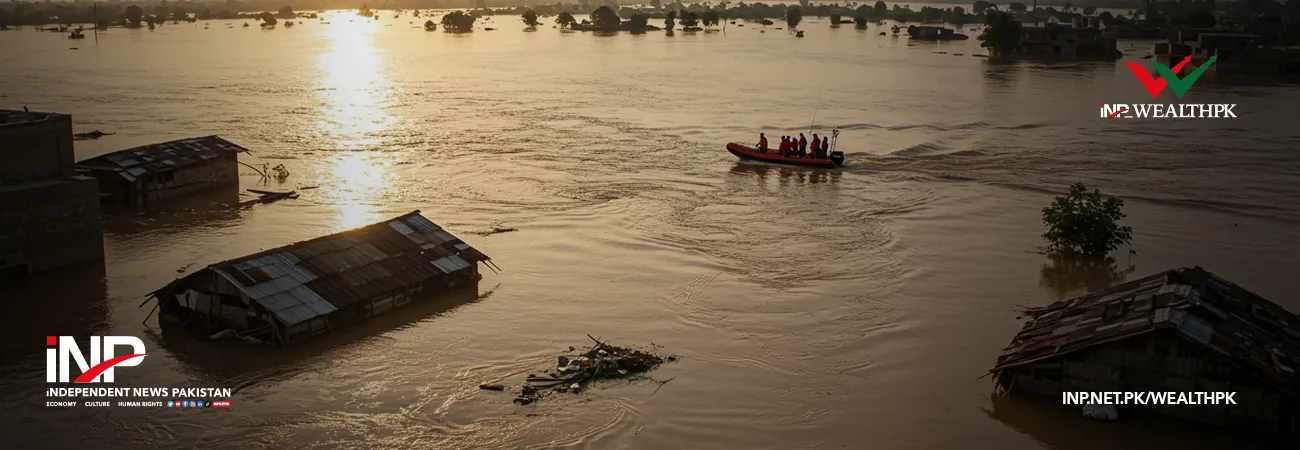آئی این پی ویلتھ پی کے
Qudsia Bano
Pakistan’s insurance industry continued its upward trajectory in fiscal year 2024-25, expanding in both asset size and market sophistication as new regulatory and technological reforms reshaped the sector.
According to the Governor’s Annual Report 2024-25 issued by the State Bank of Pakistan (SBP), total insurance-sector assets rose 13 percent during the first nine months of the fiscal year to reach Rs 3.75 trillion, while the Securities and Exchange Commission of Pakistan (SECP) issued the country’s first licence for a fully digital non-life insurance company Digi Insurance Limited.

The report said that both the life and non-life segments registered broad-based expansion despite subdued macroeconomic conditions earlier in the year. Life insurance remained the dominant component, representing more than 85 percent of total sector assets. Its asset base grew 13.2 percent, reflecting continued inflows into savings-linked and family-protection products. The non-life segment also performed strongly, with assets up 11.9 percent amid rising demand for health, motor, and property coverage. The overall improvement, the SBP noted, reflects gradual deepening of risk-management culture in Pakistan’s households and enterprises.
The Governor’s Annual Report highlighted significant progress in Shariah-compliant offerings. Family Takaful products, which follow Islamic principles for life-protection and investment, expanded their share to 15 percent of the life market, while General Takaful reached 14 percent of the non-life portfolio. The growth of takaful demonstrates strong consumer preference for ethical-finance products and aligns with the SBP’s broader strategy to strengthen Islamic finance across the system. The combined takaful asset share now represents a sizeable and fast-growing pillar of the domestic insurance landscape.
The SECP, which regulates the industry, advanced several structural reforms during the period. These included transition toward risk-based supervision (RBS) and adoption of International Financial Reporting Standard 17 Insurance Contracts (IFRS-17), both aimed at improving transparency and solvency oversight. Under the new regime, insurers must assess capital adequacy relative to the risk profile of their portfolios rather than rely on fixed capital thresholds, bringing Pakistan’s prudential standards closer to international norms.
At the same time, the regulator intensified efforts to expand coverage among low-income and informal-sector workers. The report said a proposal for a National Insurance Scheme was under development to offer basic life and health protection to informal employees who remain outside employer-based arrangements. Parallel to this, amendments to provincial labour laws are being prepared to mandate group-health and accident insurance for a wider segment of the workforce. These initiatives are designed to complement Pakistan’s social-protection agenda and reduce the economic burden of climate- or disaster-related shocks on vulnerable families.
Digitalization emerged as another defining theme of the year. The SECP’s decision to license Digi Insurance Limited as Pakistan’s first purely digital non-life insurer marked a turning point for the industry. The company will operate without a traditional branch network, using end-to-end electronic platforms for policy issuance, premium collection, and claims settlement. The SBP report described this development as “a milestone toward technology-driven inclusion,” noting that digital insurers can lower distribution costs and reach consumers in underserved regions through smartphones and online channels. The move aligns with national digital-finance reforms such as Raast Payments Pakistan and PRISM+, creating synergies between payment systems and insurance services.
Despite these advances, the report acknowledged that Pakistan’s insurance penetration—measured as premiums relative to GDP—remains low at 0.7 percent, underscoring substantial growth potential. Increasing awareness, strengthening consumer protection, and expanding micro-insurance will therefore remain key policy priorities. The SECP plans to encourage product diversification into agriculture, livestock, and climate-risk coverage. These areas are becoming increasingly important given Pakistan’s exposure to extreme weather events.
The central bank observed that higher insurance uptake can deliver broader macro-financial benefits. By mobilizing long-term savings through life-insurance and pension products, the industry contributes to domestic resource accumulation, reduces reliance on short-term bank funding, and provides institutional investors for the capital market. The SBP also noted that stable insurance companies help mitigate fiscal pressure by absorbing some of the costs associated with natural disasters or health emergencies that would otherwise fall on the public sector.
The report further pointed to ongoing cooperation between the SECP, SBP, and Ministry of Finance to harmonize regulatory frameworks and support risk-transfer mechanisms for banks and microfinance institutions. This includes exploring reinsurance pools for catastrophe risks and expanding the role of insurance in collateral protection for agricultural loans. Such integration, the SBP said, strengthens overall financial stability and complements Pakistan’s inclusive-growth strategy.
Industry analysts cited in the report attributed the sector’s sustained momentum to improving macroeconomic fundamentals, disinflation, lower interest rates, and stable exchange conditions, all of which have boosted consumer confidence and demand for long-term savings instruments. The entry of digital and takaful players, combined with risk-based supervision, is expected to sustain double-digit growth in coming years.
Concluding its review, the SBP emphasized that the FY25 performance of Pakistan’s insurance sector demonstrates growing institutional depth and readiness for technological transformation. The combination of regulatory modernization, digital innovation, and Shariah-compliant expansion positions the industry as an essential component of the national financial-inclusion framework. As the economy stabilizes, insurance penetration is projected to rise steadily, providing both household protection and a stronger base of domestic investment.
Credit: INP-WealthPk












